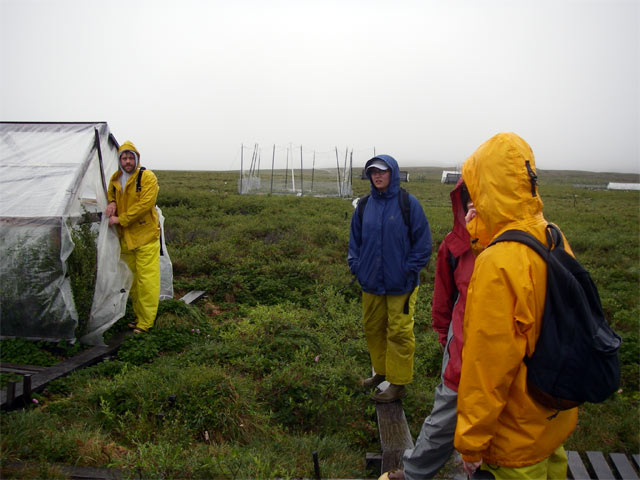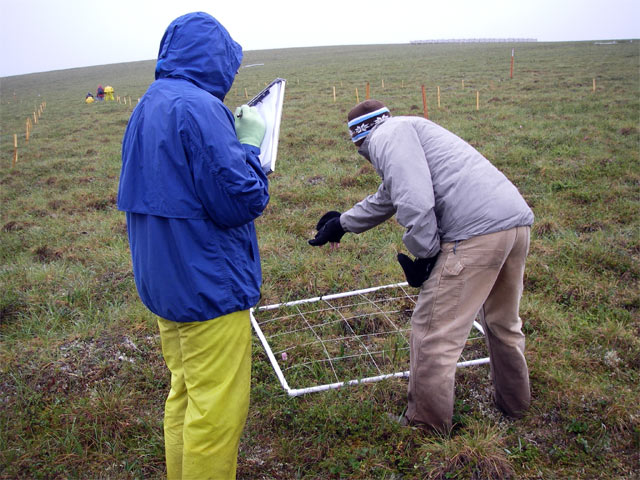( Log In ) Log In is for TREC Teachers & Researchers only
  |
| Charla_Jordan |
 Jul 25 2006, 08:01 AM Jul 25 2006, 08:01 AM
Post
#1
|
 Advanced Member    Group: TREC Team Posts: 36 Joined: 12-April 06 Member No.: 28 |
July 21, 2006 – First day in the Field
Temperature 43 degrees, raining Breakfast is at 7:30 am during which time I met up with one of my researchers Dr. Laura Gough, from the University of Texas in Arlington. We all meet in Lab 2 after breakfast for a discussion about what we are going to do today, and introductions. Since it was raining, we had to wear warm clothes, rain gear, and rubber boots—don’t forget the bug spray! We headed out of camp and onto the tundra.  In order not to damage the tundra a series of boards are connected to walk on. The first time one takes this walk, it is difficult. It is like walking on a balance beam.  Some of us are not as coordinated as we use to be--so we stop and take pictures! Laura has been coming to Toolik for 10 years now and is extremely knowledgeable about all of the experiments going on. She said that the National Science Foundation set up the LTER (Long Term Ecological Research) at Toolik Field and that each research project is approved on a six year term. She started with a tour of the plot to familiarize us. There are greenhouse experiments, which began in 1989, set up to test the effect of warmth and fertilizer on the native plant.  Notice that we are cold and wet--what we do in the name of science! In 1996, fences were added to a plot to catch the snow. You would think that a bunch of snow on plants during the winter would make them colder, but the snow acts as an insulator and actually helps the plants. Laura also explained that the area we were in was basically a tundra desert—receiving very little rainfall a year. Laura is running several experiments at one time with various other scientists and grad students. Today we will be measuring percent coverage of plants in new plots set up on the MAT (Moist Acidic Tussock). This data must be collected in order to have the initial amount and types of plants before the experiment begins to compare with the data when the experiment ends.   Counting and recording the percentages of plants in a marked area Up the hill from us, we hear a jack hammer running. Being the curious animals that we are we investigated. There is an international soils conference going on at Toolik right now. The soil scientist had dug through the tundra and down to the permafrost with the jack hammer to observe different layers of soils. Very interesting.   Back to work. We spent several hours identifying plants and counting the percentage cover of those plants. There were moss, lichen, and many more plant. This was an interesting day. I learned how to help (since I’m not a biologist) by recording the data that David gave me.  Every job is important! As I was recording the data, I noticed that the mosquitoes were increasing in numbers. I snapped this shot of David’s back—see the little critters.  Mosquitoes everywhere! The tundra is very difficult to walk across. It is like walking on sponges—this is incredibly tiring. In the morning, the boards were hard to walk on, but by the afternoon I was glad to see them. This is a shot I took of Toolik Camp on the way back for dinner.  Toolik Field Station ***To learn more about the LTER go to www.lternet.org ***Question of the day: What is permafrost? Answer in the “Ask a Teacher” section. Answer will be posted tomorrow. ***Alaskan fact: Alaska is as big as England, France, Italy and Spain combined. |
  |
1 User(s) are reading this topic (1 Guests and 0 Anonymous Users)
0 Members:

|
NSF Acknowledgment & Disclaimer | Time is now: 31st October 2024 - 05:21 AM |
Invision Power Board
v2.1.7 © 2024 IPS, Inc.








